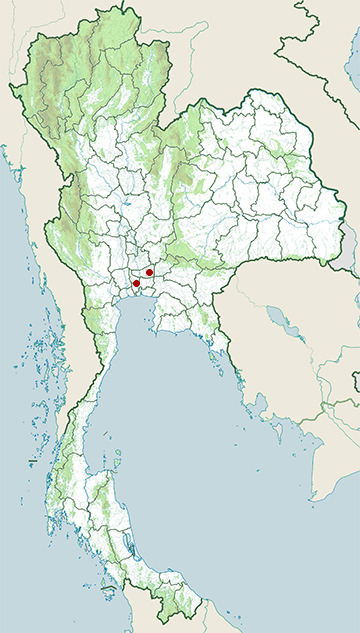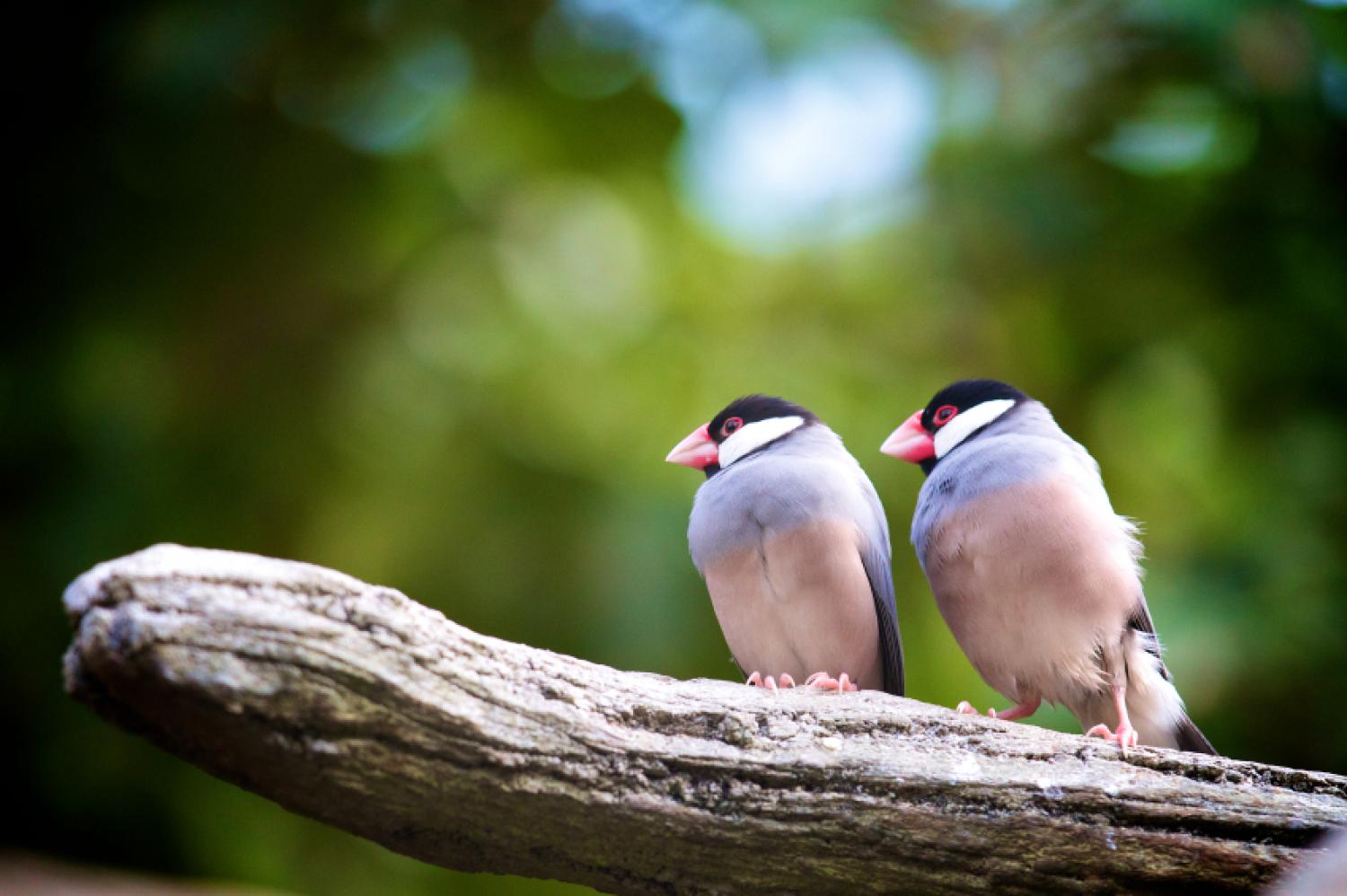Species of Thailand
Java sparrow
Lonchura oryzivora
Carolus Linnaeus, 1758
In Thai: นกกระจอกชวา
The Java sparrow (Lonchura oryzivora), also known as Java finch, Java rice sparrow or Java rice bird, is a small passerine bird. This estrildid finch is a resident breeding bird in Java, Bali and Bawean in Indonesia. It is a popular cage bird, and has been introduced into many other countries. Some taxonomists place this and the Timor sparrow in their own genus Padda.
Description
The Java sparrow is about 15 to 17 cm in length from the beak to its tip of tail feathers. Although only about the size of a house sparrow, it may be the largest species in the estrildid family. The adult is unmistakable, with its grey upperparts and breast, pink belly, white-cheeked black head, red eye-ring, pink feet and thick red bill.
Both sexes are similar. Immature birds have brown upperparts and pale brown underparts, and a plain head. Very young birds have a black beak with a pink base.
The call is a chip, and the song is a rapid series of call notes chipchipchipchipchipchip.
Molecular phylogeny indicates that this species may have originated in India and dispersed to Africa and Pacific Ocean habitats from there.
Habitat
The Java sparrow is a very gregarious bird which feeds mainly on grain and other seeds. It frequents open grassland and cultivation, and was formerly a pest in rice fields, hence its scientific name. The nest is constructed in a tree or building, and up to eight eggs are laid.
Aviculture
The Java sparrow has been a popular cage bird in Asia for centuries, first in Ming Dynasty China and then in Japan from the 17th century, frequently appearing in Japanese paintings and prints. Meiji-era writer Natsume Sōseki wrote an essay about his pet Java sparrow. In the late 1960s and early 1970s the Java sparrow was one of the most popular cage birds in the United States until its import was banned. Today it remains illegal to possess in California because of a perceived threat to agriculture, although rice-dependent Asian countries like China, Taiwan and Japan have not regulated the bird.
In Asia the Java sparrow is most often raised almost from birth by human breeders and owners, and they become very tame and attached to humans. As such, they can be normally kept in relatively small cages, but let out for indoor exercise without their attempting to escape. In captivity, a variety of colourations have been bred, including white, silver/opal, fawn/isabel, pastel, cream and agate (which currently is rare within Europe captive specimens) along with the pied Java sparrow (called the sakura buncho in Japan).
Introductions
The Java sparrow was introduced in the Indian subcontinent, but it failed to become a successful resident on the Indian mainland. In the United States there are breeding populations on several of the Hawaiian Islands, especially Oahu.
In the Caribbean, the Java sparrow was introduced to Puerto Rico where it is fairly common near San Juan. It has also been sighted in Jamaica, but is not known to occur on any of the other islands. It was also introduced to Christmas Island, off the coast of Western Australia.
Threats
The Java sparrow is considered by some countries to be an agricultural pest with respect to rice cultivation. An ongoing loss of natural habitat, hunting in some areas and trapping (as a pest) in others has led to much smaller numbers in the wild and sightings in its natural range have become increasingly uncommon. The Java sparrow is now evaluated as endangered on the IUCN Red List of Threatened Species (uplisted from vulnerable in 2018) and is listed on Appendix II of CITES. The species is also severely threatened by the illegal exotic pet trade as they are sought after for their distinctive song, according to TRAFFIC.
This article uses material from Wikipedia released under the Creative Commons Attribution-Share-Alike Licence 3.0. Eventual photos shown in this page may or may not be from Wikipedia, please see the license details for photos in photo by-lines.
Category / Seasonal Status
Wiki listed status (concerning Thai population): Introduced, endangered
BCST Category: Introduced, with feral breeding stock apparently self-supporting
BCST Seasonal status: Resident or presumed resident
Scientific classification
- Kingdom
- Animalia
- Phylum
- Chordata
- Class
- Aves
- Order
- Passeriformes
- Family
- Estrildidae
- Genus
- Lonchura
- Species
- Lonchura oryzivora
Common names
- Thai: นกกระจอกชวา
Synonyms
- Padda oryzivora
Photos
Please help us review the bird photos if wrong ones are used. We can be reached via our contact us page.
Range Map

- Bangkok Province
- Thanyaburi District, Pathum Thani


